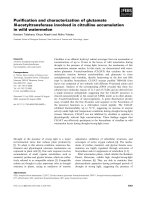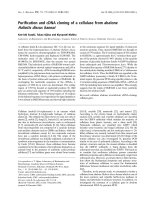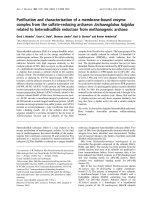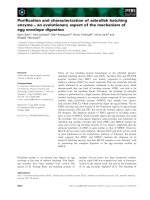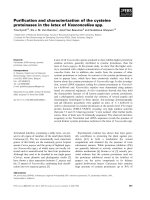Báo cáo khoa học: Purification and structural study of the b form of human cAMP-dependent protein kinase inhibitor pdf
Bạn đang xem bản rút gọn của tài liệu. Xem và tải ngay bản đầy đủ của tài liệu tại đây (444.93 KB, 6 trang )
Purification and structural study of the b form of human
cAMP-dependent protein kinase inhibitor
Rong Jin
1
, Linsen Dai
1
, Jinbiao Zheng
1
and Chaoneng Ji
2
1
Center of Analysis and Measurement and
2
State Key Laboratory of Genetic Engineering, School of Life Sciences, Fudan University,
Shanghai, PR China
The b form of human cAMP-dependent protein kinase
inhibitor (human PKIb), a novel heat-stable protein, was
isolated with high yield using a bacterial expression system.
Assays of PKI activity demonstrated that purified PKIb
inhibits the catalytic subunit of cAMP-dependent protein
kinase. FTIR, Raman spectroscopy and CD experiments
implied that human PKIb contained only small amounts of
a-helix and b-structures, but large amounts of random coil
and turn structures, which may explain its high thermosta-
bility. The details of its conformational changes in response
to heat were studied by CD experiments for the first time,
revealing that the protein unfolded at high temperature and
refolded when decreased to room temperature.
Keywords: CD; FTIR; human PKIb; MS; Raman spectro-
scopy.
Signaling through cAMP-dependent protein kinase (cAPK)
is a common pathway for many cellular processes. Regu-
lation of cAPK is achieved by both inhibition and
subcellular localization. The best understood control mech-
anism for cAPK activity is achieved through the regulatory
(R) subunit. Two catalytic (C) subunits bind to a dimer of
R subunits to yield an inactive holoenzyme. Cooperative
binding of two molecules of cAMP to each R subunit causes
dissociation of the holoenzyme complex and release of
two active C subunits [1,2].
In addition, there is a second level of regulation of cAPK
activity by protein kinase inhibitors (PKIs). The PKIs are
specific and potent inhibitors of the C subunit; however,
unlike the R subunit, PKI inhibition of the C subunit is not
relieved by cAMP [3–5]. Moreover, the PKIs also serve to
localize the C subunit in the cell. It has been demonstrated
that C–PKI complexes are more rapidly exported out of the
nucleus than the C subunit alone and that this process is both
temperature- and ATP-dependent [6]. Specifically, a nuclear
export signal has been identified on PKIs corresponding to a
leucine-rich sequence conserved in the PKIs [3,7].
To date, three mouse PKI genes encoding three isoforms
(PKIa,PKIb and PKIc) [3,8,9] and two human genes
encoding PKIa [10] and PKIc (Genbank accession numbers
AB019517 and AF182032) have been cloned. A new gene
of human PKIb (Genbank accession number AF225513)
has been cloned for the first time based on the human fetal
brain cDNA library in our laboratory [11].
To explore further the structure of human PKI and
understand the nature of the protein, here we report the
purification and structural characteristics of human PKIb.
Experimental procedures
Materials
Unless otherwise stated, all reagents were of analytical grade.
The bacterial strain Escherichia coli BL21(DE3) pLySs and
plasmid vector pET were stored in our laboratory. Enzymes
used in vector construction were from New England Biolabs.
DEAE Sepharose Fast Flow exchange media were obtained
from Amersham Pharmacia Biotech Company.
Isolation and sequencing of a cDNA clone encoding
human PKIb
A high quality cDNA library was constructed using human
fetal brain poly(A
+
) RNA by our laboratory. A full length
cDNA clone encoding human PKIb was obtained by large-
scale sequencing [11].
Construction of human PKIb expression vector
The human PKIb coding region was amplified by PCR with
oligonucleotides 5¢-CCCCATATGATGAGGACAGATT
CATCAAAAATG-3¢ and 5¢-CATGGATCCTCATTTT
TCTTCATTTTGAGGC-3¢. The amplified PCR fragment
was inserted into plasmid vector pET between the endo-
nuclease sites NdeIandHindIII. The constructed expression
vector was confirmed with by sequencing and found to
contain no errors, and was transformed into E. coli BL21
(DE3) pLySs.
Production of recombinant human PKIb
A single colony was transferred to 30 mL of M9 medium
[12], which was supplemented with 0.05% (w/v) thiamine,
Correspondence to C. Ji, State Key Laboratory of Genetic Engineer-
ing, School of Life Science, Fudan University, Shanghai 200433,
PR China. Fax: + 86 21 65642502, Tel.: + 86 21 65643958,
E-mail:
Abbreviations: C, catalytic subunit; cAPK, cAMP-dependent protein
kinase; PKIb, b form of cAMP-dependent protein kinase inhibitor;
R, regulatory subunit.
(Received 3 December 2003, revised 21 February 2004,
accepted 12 March 2004)
Eur. J. Biochem. 271, 1768–1773 (2004) Ó FEBS 2004 doi:10.1111/j.1432-1033.2004.04087.x
0.1% (w/v)
D
-biotin, 0.1% (w/v) folic acid, 0.1% (w/v)
pyridoxal, 0.01% (w/v) riboflavin, 1 m
M
MgSO
4
and
0.1 mgÆL
)1
ampicillin. Following growth overnight, the
culture was diluted with 2 L of the same medium and
cultured at 37 °C with shaking until D
600
reached 0.8–1.0.
Isopropyl thio-b-
D
-galactoside was then added to 1 m
M
and
the cultures were induced at 30 °C for 10 h. The cells were
collected by centrifugation at 2800 g for 15 min and stored
at )20 °C until use.
Purification of recombinant human PKIb
The cells from the 2 L culture were resuspended in
150mL of 10m
M
Tris/HCl (pH 8.0), 1 m
M
EDTA
(pH 8.0) [13] and lysed by the ultrasonic homogenizer
4710 series instrument (Cole-Parmer Instrument Co.,
Chicago, IL, USA). The cell debris was separated from
extract by centrifugation at 25 200 g for 15 min. By
addition of NaCl and NaAc (pH 5.0) to a concentration
of 0.2 molÆL
)1
and 0.1 molÆL
)1
, respectively, the super-
natant was incubated at 85 °C water bath for 30 min. The
denatured protein was removed by centrifugation at
25 200 g for 15 min. The supernatant was precipitated
by 70% (w/v) ammonium sulfate. After dialysis against
10 m
M
Tris/HCl (pH 8.0), the protein solution was
adjusted to pH 5.0 with acetic acid and incubated for
30 min at room temperature. Precipitated proteins were
removed by centrifugation and the supernatant was then
applied to a column of DEAE Sepharose Fast Flow
(5 · 25 cm) equilibrated with 5 m
M
sodium acetate buffer,
pH 5.0. The column was eluted with a linear gradient
(100 mL) of sodium acetate buffer, pH 5.0, from 5 to
300 m
M
, then from 300 to 600 m
M
.
The eluate was monitored by absorption at 280 nm.
The fraction containing the human PKIb proteins was
eluted at 350–500 m
M
sodium acetate buffer. The pooled
fraction was stored at )20 °C for further study. The
concentration of the proteins was determined by the
method of Lowry et al. [14] and the purity was examined
by SDS/PAGE [15].
Assay of human PKIb activity
The activity of purified human PKIb was assayed by the
inhibition of the catalytic subunit of cAPK in a 50 lL
reaction containing 0.5 units of purified catalytic subunit,
25 m
M
Tris/HCl (pH 7.4), 5 m
M
magnesium acetate,
5m
M
dithiothreitol, 20 l
M
Kemptide and 0.1 m
M
[c
32
P]ATP (200 cpmÆpmol
)1
) [13]. Reactions were incu-
bated for 20 min at 30 °Cand25lL aliquots spotted
onto phosphocellulose strips (Whatman ET31). The
filters were washed three times with 75 m
M
phosphoric
acid and radioactivity determined by scintillation spectro-
metry.
MS measurement
Electrospray MS was performed on a PerkinElmer API-165
mass spectrometer equipped with Bio-Q quadrupole and
electrospray ionization source. The mass-to-charge ratio
was set from 500 to 3000 with the step size of 0.25. Protein
concentration was 5.64 mgÆmL
)1
in H
2
O.
FTIR measurements
FTIR spectrum was measured using a PerkinElmer spec-
trometer. To maximize signal to noise radio, 1024 scans
were collected. The samples were in a PerkinElmer solution
cell with CaF
2
window and spacer. Absorbance spectrum
was obtained against a single beam background spectrum
collected with no cell. Protein concentration was
5.64 mgÆmL
)1
. The protein solutions were exchanged with
D
2
O by repeated lyophilization. The final exchanged
samples were dissolved in > 99.9% D
2
O.
Raman measurement
Raman spectrum was recorded by a Dilor-Labram 1B
Raman spectrometer (Jobin Yvon Ltd, Villeneuve d’Ascq,
France), equipped with a He-Ne laser at wavelength of
632.8 nm and 6 mW of power. The recorded resolution of
spectrum was 1 cm
)1
. Protein concentration was 0.564
mgÆmL
)1
in H
2
O.
CD measurements
CD spectrum was acquired on a 0.1 cm path length cell of a
Jasco-715 spectrometer (Jasco, Tokyo, Japan) equipped
with RTE bath/circulator (NESLAB RTE-111; NESLAB,
Tokyo, Japan). After a 25 min N
2
purge, the spectra were
recorded from 185 nm to 250 nm with a resolution of
0.2 nm and accumulated for four scans. Protein concentra-
tion was 0.071 mgÆmL
)1
in H
2
O.
Results
Cloning of the gene coding for human PKIb
The cDNA clone encoding PKIb gene contains 1057 base
pairs (Fig. 1), and is confirmed to be a novel gene by
BLAST
(NCBI) analysis (Genbank accession number AF225513).
This gene contains an open reading frame of 237 nucleotides
and a putative polyadenylation signal ATTAAA (1018–
1023) and poly(A) tail (Fig. 1). The human PKIb protein
predicted by the open reading frame is 78 amino acids in
length with a calculated molecular mass of 8468.2 Da and
PI of 4.69. It shows relatively low homogeneity to other
known human PKI isoforms: PKIa (30%) and PKIc
(23%). However, it is 74% identical to mouse PKIb1gene
in the amino acid sequence [16]. The residues of the pseudo-
substrate sequence [RRNA(26–29)] which were demonstra-
ted to play an important role in the high affinity for the
C subunit are conserved in human PKIb (Fig. 1) [4,17,18].
Likewise, a sequence highly similar to the consensus PKI
nuclear export signal, LXLXLXXLXHy(45–54), (where X
is any amino acid and Hy is any hydrophobic amino acid)
is present in human PKIb (Fig. 1) [3,6]. Based on
these elements of sequence homology, the new protein is
designated as human PKIb.
Purification and characteristics of recombinant
human PKIb
Protein expression and purification was applied as described
above. A summary of the purification procedure is given in
Ó FEBS 2004 Purification and structural study of human PKIb (Eur. J. Biochem. 271) 1769
Table 1. According to the activity assay, the activity was
retained above 95% (data not shown) and the recovery is
24% during the heat-treatment. It implied that PKIb was a
thermostable protein and part of the protein may copreci-
pitate with other denatured proteins. Starting from the 2 L
of bacterial culture, 1.52 mg of purified PKIb was obtained
with an apparent overall recovery yield of 1.2% (Table 1).
The purified PKIb showedasinglebandbySDS/PAGE
(Fig. 2). The assay of its activity demonstrated that the
purified PKIb inhibited the catalytic subunit of cAPK with
the specific activity of 6.0 · 10
4
unitÆmg
)1
(Fig. 3A).The K
i
value determined from the replots was 0.173 n
M
(Fig. 3B).
The experimental molecular mass (8468.0 Da) obtained
by electrospray MS was in complete accordance with the
theoretical mass of the human PKIb (8468.2 Da) [11]. The
identification of the gene product of human PKIb excluded
it from the interference of human PKIb-70, which was
translated from another initiated site and resulted in an
alternate protein with 7–8 residues less than human PKIb
[11,19].
Conformation of human PKIb from FTIR, Raman and CD
Absorbance spectrum and the second derivative spectrum
of FTIR for human PKIb are shown in Fig. 4A and B,
respectively. The spectrum of the conformation-sensitive
amide I¢ region (1620–1700 cm
)1
) exhibits five well defined
Fig. 1. Nucleotide and predicted amino acid
sequence of human PKIb. Aminoacidsequence
of human PKIb inferred from the nucleotide
sequence is represented below the DNA
sequence with the one-letter amino acid codes.
Nucleotide numbers are indicated at the left of
the sequence. The putative polyadenylation
signal is underlined. The pseudosubstrate
sequence is marked with a rectangular frame
and the nuclear export signal sequence is
marked with a rounded frame.
Table 1. Typical purification of recombinant human PKIb. Human
PKIb determined from electrophoresis analysis of the proteins.
Fraction
Total protein
(mg)
Human PKIb
(mg)
Recovery
(%)
Crude extract 1250 125 100
Heat-treatment 47.5 30 24
(NH
4
)
2
SO
4
fractionation
6.36 4.2 3.4
DEAE 1.52 1.52 1.2
Fig. 2. Electrophoresis analysis of proteins present in fractions from
bacterial cultures containing human PKIb expression vectors. A, 2.5 lL
of markers; B, 5 lL of the crude extract from the cells; C, 5 lLofheat-
treated crude extract; D, 5 lLof(NH
4
)
2
SO
4
fractionation; E, 5 lLof
DEAEeluate;F,10lL of DEAE eluate. Fractions were analyzed by
SDS/PAGE (12%) followed by staining with Coomassie Brilliant Blue.
An arrow indicates the position of human PKIb.
1770 R. Jin et al.(Eur. J. Biochem. 271) Ó FEBS 2004
absorption peaks at 1683, 1669, 1653, 1647 and 1636 cm
)1
,
and two shoulders at 1663 and 1625 cm
)1
, which indicate
that the amide I¢ mode consists of various overlapping
components (Fig. 4A). These component bands can be
better visualized with the second derivative spectrum in
Fig. 4B, which reveals, in addition to the major bands
described above, another band at 1675 cm
)1
. On the basis
of 21 proteins of known structure, Byler & Susi [20] have
assigned 11 well-defined frequencies in the amide I¢ region
to the secondary structural elements. Hence the peak at
1653 cm
)1
is assigned to a-helix of human PKIb; the bands
at 1675, 1636 and 1625 cm
)1
can be assigned to extended
chain structures; the bands at 1683, 1669 and 1663 cm
)1
are
possibly assigned to turns or bends; and the band at
1647 cm
)1
is likely to be the random coil structure.
As occurred in FTIR, the Raman amide III¢ and I¢
regions of human PKIb are sensitive to secondary structure
of protein and one might expect the above solution structure
to be reflected in Fig. 5. The 1652 and 1270 cm
)1
bands
canbeassignedtoa-helix in the human PKIb; the 1666
and 1247 cm
)1
bands are the characteristic frequencies
of the random coil structure. Meanwhile, the 1682 and
1255 cm
)1
bands can be assigned to extended chain or
b-turn structure [21].
The quantitative contributions of the individual amide I¢
component bands, determined by band fitting of the
absorbance spectrum of Fig. 4A, are shown in Fig. 6 and
Table 2. From Table 2, the sum of individual amide I¢
intensity and the intensity percent of each peak from human
Fig. 3. Activity analysis of inhibition of cAMP-dependent protein kinase
activity by inhibitor peptides. (A) The inhibitory potency was assayed
through incubation, increasing concentration of human PKIb with
cAPK. (B) Kinetic analysis of inhibition of cAMP-dependent protein
kinase activity by inhibitor peptides. Assays were performed essentially
as described by Thomas et al.[13]exceptthatthereactionscontain
20 lm, 10 lm, 5 lm, 2.5 lmKemptide.TheK
i
value determined from
the repots was 0.173 nm.
Fig. 4. FTIR Spectrum of human PKIb. (A) Absorbance spectrum was
measured for PKI in D
2
O and ratio determined against a single-beam
background collected with no cell. (B) Second derivative spectrum.
Fig. 5. Raman spectrum of human PKIb in H
2
O.
Ó FEBS 2004 Purification and structural study of human PKIb (Eur. J. Biochem. 271) 1771
PKIb can easily be calculated. According to the above peak
assignment, the relative contents of secondary structure in
the human PKIb based upon the fitted spectrum are shown
in Table 3.
The CD spectrum of human PKIb at 25 °C(Fig.7A)
shows that the protein has a major unordered structure, as
indicated by the presence of a very strong negative band
at 198 nm. The negative band near 220 nm results from
overlapping of the bands of b-sheet (215 nm) and a-helix
(209 nm and 222 nm) [22]. Analysis of the solution CD
spectrum of human PKIb with the computer program
CONTIN
( also
indicates that the protein has a dominant unordered
structure (Table 3), which is consistent with the result
obtained through infrared spectroscopy.
CD spectrum of thermal unfolding and refolding
of human PKIb
The conformational changes of the human PKIb were
monitored by CD from 25 to 95 °C. Four curves corres-
ponding to 25, 50, 75 and 95 °C are shown in Fig. 7A. It
was found that the absorbance at 198 nm increased when
the temperature was increased, which implied that the
human PKIb unfolded gradually. When the temperature
was gradually lowered from 95 to 25 °C(Fig.7B),the
absorbance at 198 nm decreased, which means that the
protein refolded again.
Discussion
This study described the cloning, expression, purification,
identification and characterization of a member of the PKI
family. By cloning and construction of a high- expression
Fig. 6. Amide I¢ infrared band of human PKIb in D
2
O buffer with the
best-fitted individual component band. Spectrum exhibits the individual
Lorentzen components.
Table 2. Component band positions, relative integrate intensities and
secondary structure assignment for human PKIb. Fractional area refers
to infrared amide I¢ band.
Infrared
Fractional area
Raman
Secondary structure
assignmentm (cm
)1
)
1683 0.104 1682 b-Turn
1675 0.077 Extended chain
1669 0.207 b-Turn
1663 0.238 b-Turn
1653 0.385 1652 a-Helix
1647 0.510 1666 Random coil
1636 0.379 Extended chain
1625 0.202 Extended chain
1270 a-Helix
1255 Extended chain or b-turn
1247 Random coil
Table 3. Fractional composition of secondary structure for the human
PKIb as estimated by infrared spectroscopy and CD spectroscopy.
Secondary structure Infrared amide I¢ band CD
a-Helix 0.19 0.22
Extended chain 0.31 0.29
Unordered 0.50 0.49
Fig. 7. CD spectrum of the human PKIb in the different temperatures.
(A) Increase from 25 to 95 °C and (B) decrease from 95 to 25 °Cat
185–250 nm (for clarity of comparison, only part of the spectrum is
shown).
1772 R. Jin et al.(Eur. J. Biochem. 271) Ó FEBS 2004
vector for human PKIb, milligrams of human PKIb could
be produced conveniently and rapidly (Table 1). Heat
treatment, DEAE ion exchange chromatography and gel
filtration chromatography were usually the main processes
for purification of PKIs [13]. In this process of purification,
with the addition of NaCl and NaAc to the extract prior to
heat treatment, many more contaminants were removed
compared to the previous reports [4,13]. Followed by
ammonium sulfate precipitation and DEAE sepharose fast
flow chromatography, highly pure protein of human PKIb
was readily produced. By reducing the step of gel filtration
chromatography, the purification process was simplified.
This method would be helpful to purify other kinds of
proteins in the PKI family.
The combined results of FTIR and CD showed that
human PKIb contained large amounts of random coil
and turn structures, with a small amount of a-helix and
b structures. However, this was compatible with previous
reports [23] that minimal structure should be maintained to
resist both high temperature and low pH. The conforma-
tional changes of protein against temperature were evalu-
ated by CD spectrum. It could be the reason why human
PKIb was a heat-stable protein, as it unfolded at high
temperature and refolded when gradually descended to
room temperature. This mechanism may also be applied to
other kinds of protein in the PKI family.
Bacterially produced human PKIb provided a useful tool
for studies of the catalytic subunit of the cAMP-dependent
protein kinase. Its ability to readily alter the PKI coding
sequence could permit further studying of human PKIb and
understanding of the function of cAPK.
Acknowledgements
This study was supported by the National Natural Science Foundation
Grant of China (30070161).
References
1. Taylor, S.S., Buechler, J.A. & Yonemoto, W. (1990) cAMP-
dependent protein-kinase – framework for a diverse family of
regulatory enzymes. Ann. Rev. Biochem. 59, 971–1005.
2. Hauer, J.A., Barthe, P., Taylor, S.S., Parello, J. & Padilla, A.
(1999) Two well-defined motifs in the cAMP-dependent protein
kinase inhibitor (PKI alpha) correlate with inhibitory and nuclear
export function. Protein Sci. 8, 545–553.
3. Collins, S.O. & Uhler, M.D. (1997) Characterization of PKI
gamma, a novel isoform of the protein kinase inhibitor of cAMP-
dependent protein kinase. J. Biol. Chem. 272, 18169–18178.
4. Gamm, D.M. & Uhler, M.D. (1995) Isoform-specific differences
in the potencies of murine protein-kinase inhibitors are due to
nonconserved amino-terminal residues. J. Biol. Chem. 270, 7227–
7232.
5. Walsh,D.A.,Angelos,K.L.,VanPatten,S.M.,Glass,D.B.&
Garetto, L.P. (1990) Peptides and Protein Phosphorylation (Kemp,
B.E.,ed.),pp.43–84.CRCPress,Inc,BocaRaton.
6. Wen, W., Harootunian, A.T., Adams, S.R., Feramisco, J., Tsien,
R.Y., Meinkoth, J.L. & Taylor, S.S. (1994) Heat-stable inhibitors
of cAMP-dependent protein kinase carry a nuclear export signal.
J. Biol. Chem. 269, 32214–32220.
7. Wen, W., Meinkoth, J.L., Tsien, R.Y. & Taylor, S.S. (1995)
Identification of a signal for rapid export of proteins from the
nucleus. Cell 82, 463–473.
8. Olsen, S.R. & Uhler, M.D. (1991) Isolation and characterization
of cDNA clones for an inhibitor protein of cAMP-dependent
protein kinase. J. Biol. Chem. 266, 11158–11162.
9. Scarpetta, M.A. & Uhler, M.D. (1993) Evidence for two addi-
tional isoforms of the endogenous protein kinase inhibitor of
cAMP-dependent protein kinase in mouse. J. Biol. Chem. 268,
10927–10931.
10. Olsen, S.R. & Uhler, M.D. (1991) Inhibition of protein kinase-a by
overexpression of the cloned human protein-kinase inhibitor. Mol.
Endocrinol. 5, 1246–1255.
11. Mao, Y.M. & Xie, Y. (1999) Chinese Patent 99124211.4.
12. Sambrook, J., Fritsch, E.F. & Maniatis, T. (1989) Molecular
Cloning: a Laboratory Manual, 2nd edn. Cold Spring Harbor
Laboratory, Cold Spring Harbor, NY.
13. Thomas, J., Vanpatten, S.M., Howard, P., Day, K.H., Mitchell,
R.D., Sosnick, T., Trewhella, J., Walsh, D.A. & Maurer, R.A.
(1991) Expression in Escherichia coli and characterization of the
heat-stable inhibitor of the cAMP-dependent protein kinase.
J. Biol. Chem. 266, 10906–10911.
14.Lowry,O.H.,Rosebrough,N.J.,Farr,A.L.&Randall,R.J.
(1951) protein measurement with the folin phenol reagent. J. Biol.
Chem. 193, 265–275.
15. Laemmli, U.K. (1970) Cleavage of structural proteins during the
assembly of the head of bacteriophage T4. Nature 227, 680–685.
16. Zheng,L.,Yu,L.,Tu,Q.,Zhang,M.,He,H.,Chen,W.&Gao,J.,
Yu, J., Wu, Q. & Zhao, S. (2000) Cloning and mapping of human
PKIB and PKIG, and comparison of tissue expression patterns of
three members of the protein kinase inhibitor family, including
PKIA. Biochem. J. 349, 403–407.
17. Scott, J.D., Glaccum, M.B., Fischer, E.H. & Krebs, E.G. (1986)
Primary structure requirement for inhibition by the heat-stable
inhibitor of the cAMP-dependent protein kinase. Proc. Natl.
Acad. Sci. USA 83, 1613–1616.
18. Glass,D.B.,Cheng,H C.,Mende-Mueller,L.,Reed,J.&Walsh,
D.A. (1989) Primary structural determinants essential for potent
inhibition of cAMP-dependent protein kinase by inhibitory pep-
tides corresponding to the active portion of the heat-stable
inhibitor protein. J. Biol. Chem. 264, 8802–8810.
19. Kumar, P., Van Patten, S.M. & Walsh, D.A. (1997) Specific tes-
ticular cellular localization and hormonal regulation of the PKI
and PKI isoforms of the inhibitor protein of the cAMP-dependent
protein kinase. J. Biol. Chem. 272, 20011–20020.
20. Byler, D.M. & Susi, H. (1986) Examination of the secondary
structure of proteins by deconvolved FTIR spectrum. Biopolymers
25, 469–487.
21. Tu, A.T. (1982) Raman Spectroscopy in Biology: Principles and
Application. Wiley, New York.
22. Johnson, W.C. (1990) Protein secondary structure and circular-
dichroism – a practical guide. Proteins Struct. Funct. Genet. 7,
205–214.
23. Reed, J., de Ropp, J.S., Trewhella, J., Glass, D.B., Liddle, W.K.,
Bradbury, E.M. & Walsh, D.A. (1989) Conformational analysis of
PKI (5–22) amide, the active inhibitory fragment of the inhibitor
protein of the cyclic AMP-dependent protein kinase. Biochem. J.
264, 371–380.
Ó FEBS 2004 Purification and structural study of human PKIb (Eur. J. Biochem. 271) 1773



